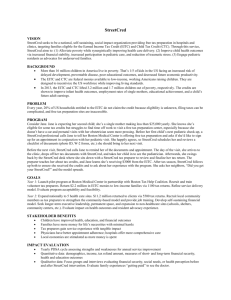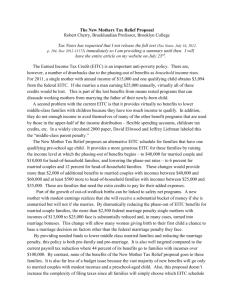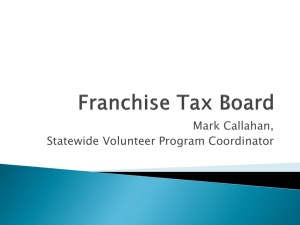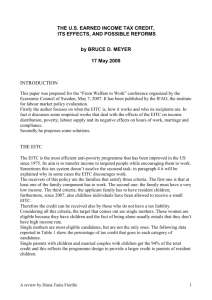Lecture 20: Earned Income Tax Credit (EITC)
advertisement
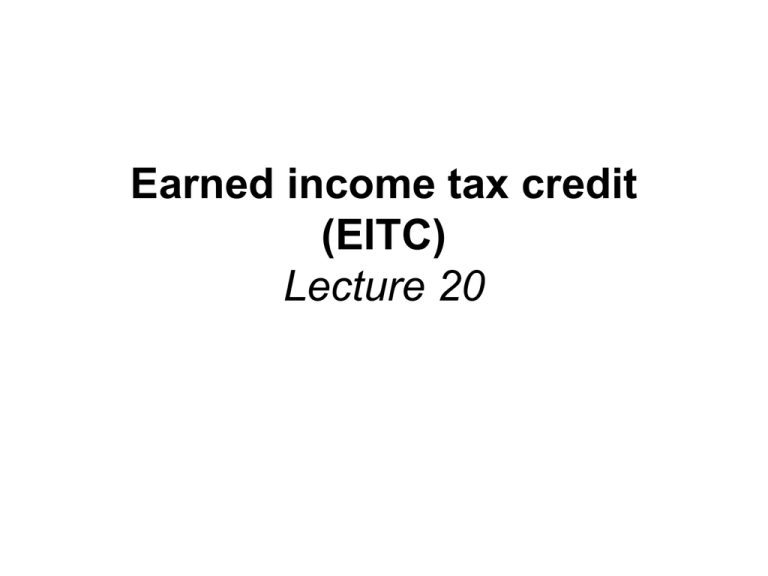
Earned income tax credit (EITC) Lecture 20 Reading Assignment and Sources • • Reading Assignment: – Greenstein, “The Earned Income Tax Credit: Boosting Employment, Aiding the Working Poor,” http://www.cbpp.org/7-19-05eic.htm – DeParle, Ch. 17: Money: Milwaukee, Summer 1999 Sources: – A. Nagle and N. Johnson, “A Hand Up: How State Income Tax Credits Help Working Families Escape Poverty In 2006,” Center for Budget and Policy Priorities, www.cbpp.org – S. Holt, “The Earned Income Tax Credit at Age 30: What We Know,” The Brookings Institution, February, 2006 http://www.brookings.edu/metro/pubs/20060209_Holt.pdf – Citizens for Tax Justice, “The Hidden Entitlements,” 1996 http://www.ctj.org/hid_ent/part-3/part3-3.htm Today’s Questions • • • • • • What is the EITC and how does it work? Who receives the EITC? How large are the credits? Which States supplement the credit? Why is the EITC politically popular? Will this popularity last?-- problems with the EITC What is the EITC and how does it work? • A tax reduction and wage supplement for low- and moderate-income families • Available to both single parent,two parent families, and childless low-income workers • Must work to be eligible • A refundable credit, which means that if the credit amount is larger than a family’s income tax bill, the family receive a refund check. • Usually claimed when the income tax return is filed. Can opt for equal monthly payments. Parameters are adjusted for inflation each year. •Source: A. Nagle and N. Johnson, “A Hand Up: How State Income Tax Credits Help Working Families Escape Poverty In 2006,” Center for Budget and Policy Priorities, www.cbpp.org Example 1 • A single parent with one child, working full time throughout the year at a wage of $10 per hour, earns $20,800 per year. This worker owes $710 in 2005 federal income taxes which are with held from the paycheck during the year. The family also qualifies for an EITC of $1,635. The EITC allow the family to get back the $710 it paid in income taxes and to receive an additional refund of $925. The EITC refund serve to offset some of the worker’s $1,591 in payroll taxes that also were paid during the year. Source: Nagle and Johnson, 2006 Example 2 • A single parent with two children working nearly full-time--50 weeks per hear at 38 hours per week--at the minimum wage of $5.15 per hour has an annual income of about $9,800. After subtracting payroll tax and adding the $3,920 federal EITC for which the family qualifies, the family’s cash income totals $12,970, or abo9ut $2,461 below the 2005 poverty line for a family of three. • Source: Nagle and Johnson, 2006. Who Receives the EITC? • 5.4 million poor families with at able-bodied parents – 3.3 million or 66 percent had at least one parent in the labor force – Among poor families with children in which one or both parents worked anytime during the year, the parents worked at combined 44 weeks. • About 75 percent of the families on welfare (TANF, SSI, or GA) had a parent working in 2004 Who Receives the EITC? Source: Holt, 2006 Who Receives the EITC? Source: Holt, 2006 Who Receives the EITC? Who Receives the EITC? Source: Holt, 2006 How large are the credits? Source: Nagle and Johnson, 2006 Which States supplement the credit? • Nineteen States (counting the District of Columbia as a State) supplement with Federal EITC. • A campaign is being waged to convince the remaining States to do likewise. Source: Nagle and Johnson, 2006 Source: Nagle and Johnson, 2006 Why is the EITC Politically Popular? • Encourages work – More people enter the labor force – Workers work more hours • Reduces welfare costs – Grogger concluded that the EITC “may be the single most important policy for explaining recent increases in work and earnings and declines in receipt of cash welfare assistance among femaleheaded families.” Source: Greenstein, 2005 Why is the EITC Politically Popular?, Cont. • Reduces poverty – By 4.4 million in 2003 – The poverty rate among children would be 1/4 higher without EITC – Lifts more children out of poverty than any other program Child Credit • Children who are under 17 as of the end of the tax year, you can get a $1,000 tax credit per child on your tax return. • Phased out for taxpayers with modified adjusted gross income – reduced (but not below zero) by $50 for each $1,000 (or fraction thereof) by which the taxpayer's modified adjusted gross income exceeds the threshold amount. – Threshold amounts: • $110,000 in the case of a joint return • $75,000 in the case of an unmarried individual • $55,000 in the case of a married individual filing a separate return Will this popularity last?-problems with the EITC • Fraud – Overpayments to eligibles – Fraudulent claims from ineligibles • Nonparticipation • Marriage penalty encourages cohabitation – A two earner, two-child couple making $35,000 (with a 60/40% earnings split) can save $3,923 a year in federal income taxes by avoiding marriage (EITC: $4,400 vs. $476). Will this popularity last?-problems with the EITC, cont. • High cumulative marginal tax rates – When earnings are in the phase-out range, the combined marginal tax rates for the may create a substantial work disincentive • Federal income taxes • Payroll tax • EITC phase-out 15% 7% 21% – Add a State income tax (3 to 6%) to this 43% marginal tax rate if relevant. – Add 24% phase-out rate for Food Stamps. – Cumulatively the marginal tax rate face by lowincome Americans is in the range of 43- 73% ! Will this popularity last?-problems with the EITC, cont. • Subsidy to low-wagewages employers S S’ – They would have to raise their offers in the absence of the w EITC weitc D workers Will this popularity last?-problems with the EITC, cont. • The EITC is an entitlement! Proposed Improvements • Increase tax credit for low-income workers without children • Increase tax credit for families with three or more children • Eliminate the marriage penalty • Simplify filing procedures


